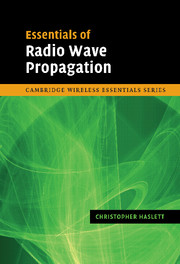Book contents
- Frontmatter
- Contents
- Preface
- Acknowledgements
- 1 Propagation in free space and the aperture antenna
- 2 Point-to-area transmission
- 3 The effect of obstacles
- 4 Reflection, scatter and penetration
- 5 Estimating the received signal strength in complex environments
- 6 Atmospheric effects
- 7 System design and interference management
- 8 Software-based tools
- 9 Summary
- Appendix 1 The decibel scale
- Appendix 2 Phasor arithmetic and phasor diagrams
- Appendix 3 Formula sheet
- Appendix 4 Explanation of the link budget
- Further reading
- References
- Recommendations of the Radiocommunication Bureau of the International Telecommunications Union (ITU), Geneva
- Author's biography
- Index
2 - Point-to-area transmission
Published online by Cambridge University Press: 09 August 2009
- Frontmatter
- Contents
- Preface
- Acknowledgements
- 1 Propagation in free space and the aperture antenna
- 2 Point-to-area transmission
- 3 The effect of obstacles
- 4 Reflection, scatter and penetration
- 5 Estimating the received signal strength in complex environments
- 6 Atmospheric effects
- 7 System design and interference management
- 8 Software-based tools
- 9 Summary
- Appendix 1 The decibel scale
- Appendix 2 Phasor arithmetic and phasor diagrams
- Appendix 3 Formula sheet
- Appendix 4 Explanation of the link budget
- Further reading
- References
- Recommendations of the Radiocommunication Bureau of the International Telecommunications Union (ITU), Geneva
- Author's biography
- Index
Summary
Point-to-area transmission is the generic name given to the way in which broadcasting transmitters or base stations for mobile communications provide coverage to a given area. A general overview is provided in order to deliver the most significant information as quickly as possible. Following that, the concept of electric field strength as an alternative to power density, prediction methods and the effect of frequency are explained in more detail. Digital mobile radio is selected for further study as a specific example of point-to-area communication. Path-loss-prediction methods specific to digital mobile radio are examined and various types of antenna that are used for the base stations of these systems are described. Finally, the effect that interference can have on the coverage range of a base station is explained.
Overview
The simplest form of antenna used is an ‘omni-directional’ antenna. These radiate equally in all directions in the horizontal plane. They often have a narrower beam (perhaps less than 20 degrees) in the vertical plane. Such antennas typically have a gain of 10 dBi. Two collinear wire elements that are fed at their junction with a signal form what is known as a dipole antenna. The basic omni-directional antenna is a dipole that is half a wavelength in height (a ‘half-wave dipole’ with each of the wire elements being a quarter of a wavelength in length). This has a wide vertical beam and has a gain of 2.1 dBi.
- Type
- Chapter
- Information
- Essentials of Radio Wave Propagation , pp. 26 - 49Publisher: Cambridge University PressPrint publication year: 2007



